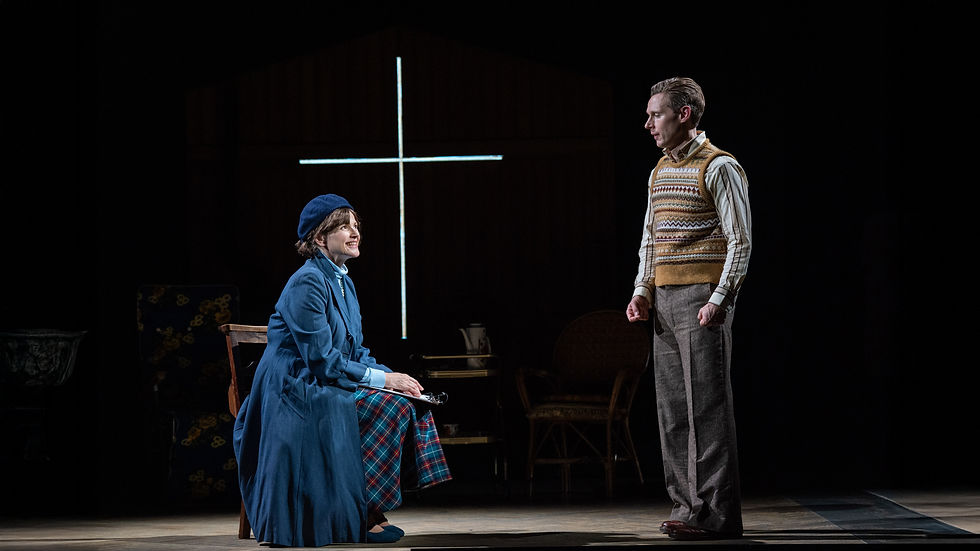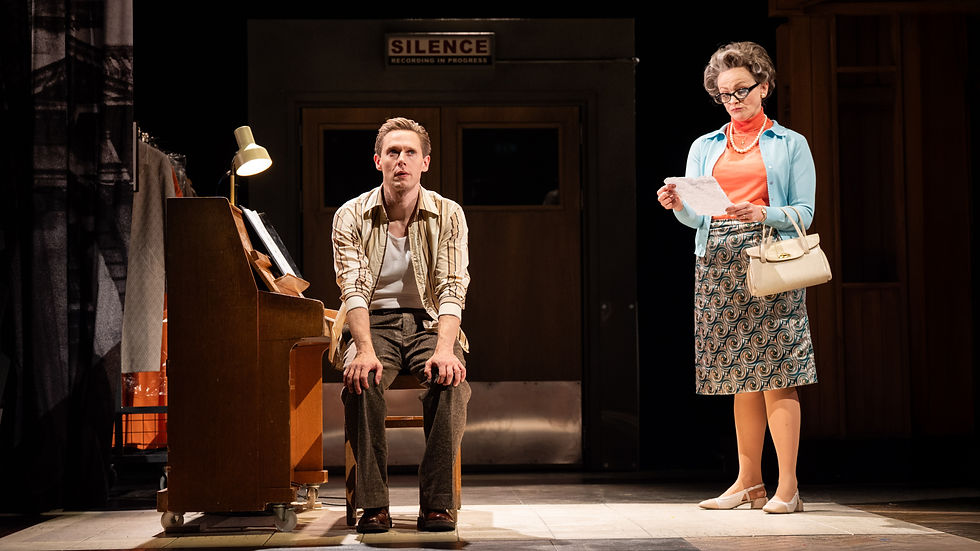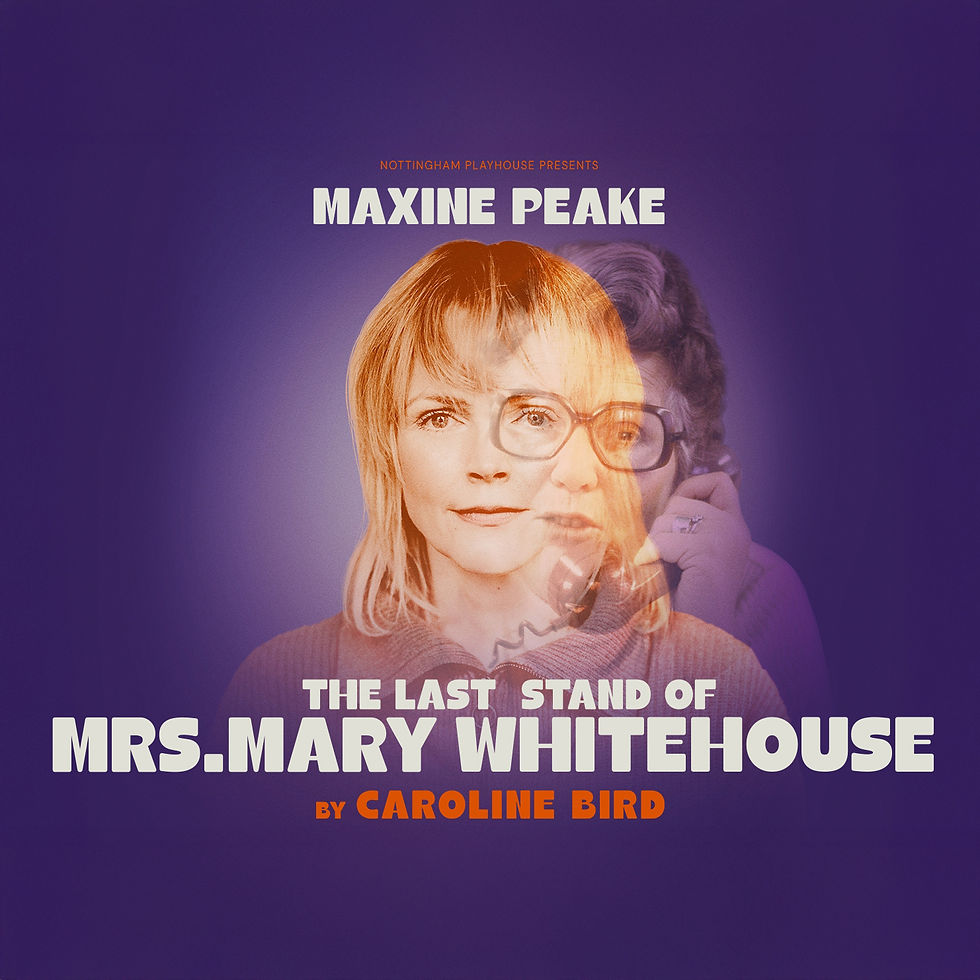The Last Stand of Mrs. Mary Whitehouse - Review
- Thomas Levi

- Sep 10, 2025
- 5 min read
★★★★☆
Mary Whitehouse spent her life battling what she saw as filth on stage and screen, so what happens when she becomes the star of a play herself? The Last Stand of Mrs Mary Whitehouse asks whether this self-styled crusader is remembered as a beacon for decency or as a meddling censor whose grip on the arts destroyed creativity. But the bigger question lingers: is this a show she’d proudly claim as part of her legacy, or one so smutty she’d be desperate to shut down?

In a brilliantly wicked and thought-provoking two-hander by Caroline Bird, The Last Stand of Mrs Mary Whitehouse dives deep into the fierce culture wars of 1970s Britain, centred on the unexpected might of Mary Whitehouse—a pearl-clutching moral guardian and a woman branded by critics as “the most dangerous in Britain.” Played with sharp humanity by Maxine Peake, this “sweet grandmother” becomes a formidable adversary for the BBC and the media, which she views as corrupted. The play traces her fallout from the infamous blasphemy trial against Gay News, revealing the shocking influence hiding behind her prim facade. Samuel Barnett dazzles in multiple rapid-fire roles, from her mother to Margaret Thatcher and even Jesus, highlighting how far-reaching Whitehouse’s battle really was. With biting wit and no easy answers, the production challenges us to question where the line between censorship and conviction lies, and whether empathy for ideological opponents is a strength or a peril.

The heart and brilliance of this production rests firmly on the shoulders of its two performers, Maxine Peake and Samuel Barnett, and what a privilege it is to watch two world-class actors at the height of their powers.
Peake delivers a sensational Mary Whitehouse, embodying her across decades with breathtaking precision. The production’s time-hopping structure demands sudden shifts in age, energy, and outlook, and Peake navigates these transformations with absolute conviction. One moment she’s the steely-eyed campaigner ready to take on the BBC, the next she’s a younger, almost naïve version of herself, brought to life with nothing more than a wig change and a shift in physicality. It’s mesmerising. There’s even an uncanny echo of Julie Walters’ Petula from Dinnerladies in Peake’s “old lady” Whitehouse — an ironic delight, given Peake herself starred in that sitcom. What shines through most, however, is her ability to balance charm with deep flaw: a woman utterly convinced by her own crusade, even when it tips into dangerous obsession.
If Peake is the anchor, then Barnett is the dynamo. His performance is nothing short of astonishing as he shapeshifts through a dizzying 15 characters, each one vivid, distinct, and fully realised. Male, female, comic, tragic — Barnett switches between them with a chameleon-like fluidity that never feels like a gimmick. His portrayals of gay characters in particular are imbued with authenticity and depth, resisting caricature and instead offering raw, human portraits that cut straight to the heart. Jacob, a musician who confronts Whitehouse after heckling her at the University of Birmingham, is especially compelling. Barnett dials down the comedy here, allowing a real challenge to Mary’s worldview to emerge. And then, just as powerfully, he can lean into pure theatrical joy: Act Two’s entrance as The Iron Lady, Margaret Thatcher, was met with roars of laughter and remains one of the evening’s most memorable moments.
Together, Peake and Barnett elevate Caroline Bird’s play into something truly unmissable. Their chemistry, skill, and total command of the stage make this production a masterclass in acting, a reminder of just how thrilling theatre can be when you watch performers working at the pinnacle of their craft.

Peter Butler’s stage design makes a striking first impression — though not necessarily a comforting one. When the curtain rose on clothes rails, mismatched chairs, a garden shed, and a slack curtain backdrop, my initial thought was that it looked cluttered, almost careless. But as the story unfolded, this stripped-back aesthetic proved to be a clever device. With seamless transitions — aided by a tireless onstage crew — the design became a fluid storytelling tool, able to whisk us from kitchens to courtrooms without ever slowing the momentum. The visual simplicity was lifted further by Malcolm Rippeth’s inventive lighting design: audience lights breaking the fourth wall, a disco ball gleefully marking Mary’s “death,” and stark spotlights for her internal reckonings. Annie May Fletcher’s sound design also supported the piece beautifully, though one odd misstep did stick out: a voice-over introducing Act Two with Mary “arriving from England”… to a scene already set in England. A small but distracting incongruity in an otherwise sharp design package.
Caroline Bird’s script deserves praise for its ambition and scope. She juggles verbatim moments with biting humour, weaving a dense net of history, politics, and satire into something accessible. It’s witty, pointed, and bursting with research, but crucially, it’s entertaining. That said, there are points where the text begins to circle itself. The repeated focus on Whitehouse’s hostility toward homosexuality sometimes risks feeling blunt, especially given the absence of a consistent gay character for the audience to invest in. Without that anchor, those sections occasionally feel like they’re pointing fingers without building depth.
Yet when the writing lands, it does so with extraordinary force. A standout moment for me was the confrontation between Mary Whitehouse and feminist journalist Jill Tweedie (played by Barnett). This scene crackled with tension because it was a genuine intellectual duel, not a shouting match. For once, Whitehouse wasn’t met with protestors or hecklers but with someone willing to sit opposite her and challenge her ideas directly, without malice or mockery. The result was electrifying. In many ways, this exchange encapsulated the whole point of the play: a clash of belief systems, laid bare without subtlety or ornament. And frankly, it didn’t need them.

With a runtime of around two hours and forty minutes (including the interval), The Last Stand of Mrs. Mary Whitehouse is not a short evening in the theatre. Thankfully, the pacing keeps the action moving briskly, with comedy, drama, and history deftly interwoven to keep audiences engaged. That said, not every sketch earns its keep. The opening of Act Two, complete with a Tupperware box full of dildos and a flurry of ’80s references, is undeniably funny but adds little to the overall narrative. A little trimming here and there could make an already sharp play even sharper.
Sarah Frankcom’s direction ensures the piece never loses clarity, with fluid movement by Jennifer Jackson, crisp voice work coached by Liz Flint, and wigs by Campbell Young Associates that allow the actors to shift characters seamlessly before our eyes. Together, this creative team has built a strong platform for two exceptional performers to shine, resulting in a thoroughly entertaining evening. As an opener for Nottingham Playhouse’s 2025/26 season, it sets the bar confidently high for Eureka Day in October.
And yet, perhaps the greatest compliment one can pay this production is that Mary Whitehouse herself would have loathed it. Stuffed with innuendo, sex jokes, and challenges to her worldview, it is the kind of theatre she would have campaigned to ban. If Whitehouse would have hated it, then surely that means Nottingham Playhouse has done something very right indeed.






















































Comments